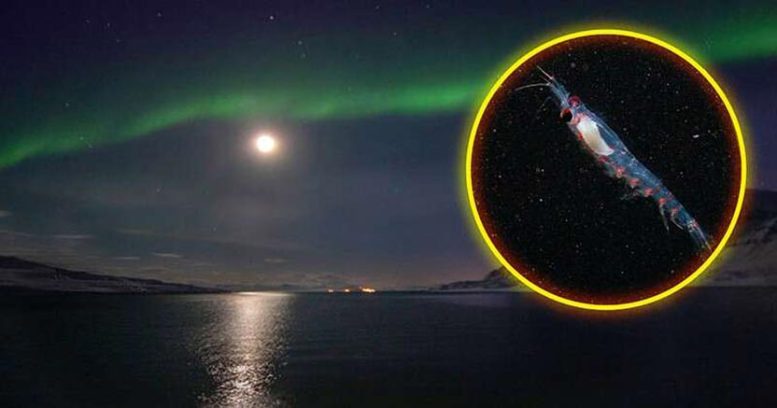
Diffuse sunlight, moonlight, aurora, and artificial light can all be seen during the Arctic Polar night, including near Kongsfjorden, Svalbard. Svalbard is an archipelago northeast of Greenland. When it is lightest in the Arctic polar night, usually around the middle of the day known as midday twilight, Arctic krill (inset) know to swim down to the bottom in order to hide from predators. When it is darkest in the Arctic polar night, they swim to the surface in search of bioluminescent food. Credit: Photo by Geir Johnsen, Photo illustration by Tammy Beeson
New research explores animals’ visual rhythms during the Arctic polar night.
Around 11:30 a.m. or so, you might find yourself hankering for lunch. The reason for this is that our biological rhythms are trained to tell ourselves when we are hungry, and when we do get that craving, our bodies know that it’s time to eat. The same is true for visual rhythms.
During the day, it is typically lighter than at night. Because of this, our visual system changes so that it can be ready to work under brighter light conditions. During the night time, our eyes become more sensitive to adjust to the lack of light available.
It turns out that the same thing happens for Arctic krill. When it is lightest in the Arctic polar night — a time of year at high latitudes when the sun remains below the horizon for the entire 24-hour period — usually around the middle of the day known as midday twilight, the Arctic krill know to swim down to the bottom in order to hide from predators. When it is darkest in the Arctic polar night, that’s when they swim to the surface in search of bioluminescent food.
A new study published in PLOS Biology looked at this visual sensitivity rhythm in Arctic krill during the Arctic polar night.
Jonathan Cohen, associate professor at the University of Delaware’s School of Marine Science and Policy in the College of Earth, Ocean and Environment, served as the lead author on the paper and said that it ties into larger work looking at the biological processes that take place during Arctic polar night.
“The dogma for a long time was that when the sun stays below the horizon, biology just goes into suspended animation, and then everything kicks back up again when the sun comes back above the horizon in the spring,” said Cohen. “Our work has found that is not the case. Instead, you’ve got organisms that are active throughout that polar night period when the sun is below the horizon. There is also more light than you would think, even when the sun is below the horizon, and it has biological impacts.”
One of those biological impacts is on the visual sensitivity rhythms of krill.
To conduct the research, Cohen traveled to the Svalbard archipelago in the Arctic Ocean — northeast of Greenland, if you’re searching a globe— conducting research both on a research vessel out at sea and at a light observatory on land.
Using underwater acoustic technology, the researchers could tell that the krill were active and present during the Arctic polar night.
“In this paper, we are really asking this question: is there enough light in the Arctic polar night to entrain their biological rhythms? And we found that there was,” said Cohen.
The krill used the external light in a variety of different ways. It aids their visual system for moving up and down in the water column to find food as well as helps them control their own bioluminescence to avoid being eaten by a predator.
Unlike at the lower latitudes, when there are distinct periods of a bright day and a dark night, in the Arctic, there are different sources during the polar night such as moonlight and the Aurora Borealis — the northern lights — that contribute light at different times. This expands and shifts the time period when light is available.
“You still see that difference between day and night up there, but it gets a little blurred by the presence of the moon and the aurora because those light levels are enough to basically come pretty close to what you might see during the time of midday,” said Cohen.
Even though the light in the Arctic polar night does not fluctuate as much as it does in the lower latitudes, it does undergo changes. While the sun is below the horizon, it still produces an oscillation of light intensity and these light changes are sensed by the krill.
Animals and people entrain their biological clocks to synch with visual cues such as cyclic light — light becoming darker or brighter — which tells them to turn on or off certain genes.
Looking for these visual mechanisms in the krill, the researchers used what is known as extracellular electroretinogram recording under constant darkness to get a better idea of how the krill adapt to light changes. Researchers ran two experiments, one to expose krill in the lab to flashes of different light intensities to measure sensitivity, and one that exposed them to flashes of the same intensity at different times of day to measure any impact the time had on visual sensitivity.
“We can determine how well a krill can detect that light flash because we are doing this with animals we’ve collected and kept in the dark,” said Cohen. “So we know they were only exposed to the light in the environment that they had at collection, and it was that light that set their biological clocks.”
In addition to the lab experiment, the researchers also relied on the acoustic data — which told them when the krill were undergoing their vertical migrations — and light data collected both at sea and on land which told them when light levels were at their highest during the Arctic polar night.
Cohen said there are a few implications for this new finding on krill. One is that the Arctic krill can set their biological clocks using very small changes in light over the 24-hour day — among the lowest that has ever been measured.
This study also helped them infer how krill use the external light and their own bioluminescence to shield themselves from potential predators. When swimming in the water, the krill will place their backs up and their bellies down. Their bellies produce bioluminescence — kind of like the krill shining little light bulbs from their bellies.
Underwater, light is only detectable from directly overhead. So by shining this light from their belly, they erase the shadow that they would present when viewed from underneath.
“It’s called counter illumination, and they’re producing light which blurs their shadow so that they can’t be seen by predators from beneath,” said Cohen. “What we think this rhythm does is it allows them to better tune that light shadow.”
They are also able to conserve energy and stay safe by staying low in the water column until it is time to feed. Whereas other animals might move up or down in response to a passing cloud that appears like a dark shadow overhead, the krill are able to ignore those shadows and conserve their energy.
With these new findings in hand, Cohen will head back to the Arctic in January 2022 to continue researching the implications that artificial light in the Arctic polar night has on marine species in the Arctic.
Reference: “Photophysiological cycles in Arctic krill are entrained by weak midday twilight during the Polar Night” by Jonathan H. Cohen, Kim S. Last, Corie L. Charpentier, Finlo Cottier, Malin Daase, Laura Hobbs, Geir Johnsen and Jørgen Berge, 19 October 2021, PLOS Biology.
DOI: 10.1371/journal.pbio.3001413
Funding for this project came from the Norwegian Research Council and the Natural Environment Research Council in the United Kingdom.




